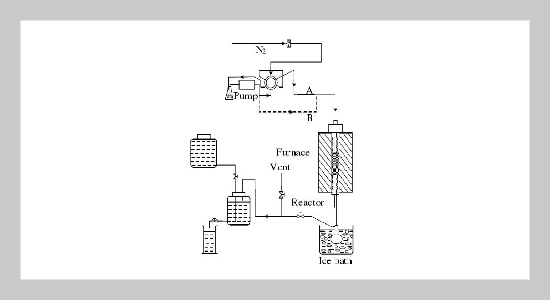REFERENCES
- [1]Jayaraman P., Ni, S. F., Li D., “Metal dithiolene complexes in olefin addition and purification, small molecule adsorption, H2 evolution and CO2 reduction”, Coordination Chemistry Reviews. Vol. 420, 213398 (2020).
- [2]Ana M., F., P., Hongyi S., Maria F. C., Armando J. L. P., et al, “Recent developments in vanadium-catalyzed olefin coordination polymerization”, Coordination Chemistry Reviews. Vol. 416, 213332 (2020).
- [3]Samaneh B., Abdolreza M., Fahime P., et al, “Advances in high carbon dioxide separation performance of poly (ethylene oxide)-based membranes”, Journal of Energy Chemistry. Vol. 46, pp. 30-52 (2020).
- [4]Roberto P., Alazne G., María L. F., et al. “Upgrading of heavy coker naphtha by means of catalytic cracking in refinery FCC unit”, Fuel Processing Technology. Vol. 205, 106454 (2020).
- [5]Jeong, S. M., Chae, J. H., Lee, W. H. “Study on the catalytic pyrolysis of naphtha over a KVO3/α-Al2O3 catalyst for production of light olefins”, Industrial & Engineering Chemistry Research, Vol. 40, No. 26, pp. 6081-6086 (2001).
- [6]Lee, W. H., Jeong, S. M., Chae, J. H., et al. “Coke formation on KVO3-B2O3/SA5203 catalysts in the catalytic pyrolysis of naphtha”, Industrial & Engineering Chemistry Research, Vol. 43, No. 8, pp. 1820-1826 (2004).
- [7]Reza, K., Shima, O., Ramin, K., “Catalytic cracking of light naphtha over hierarchical ZSM-5 using rice husk ash as silica source in presence of ultrasound energy:Effect of carbon nanotube content”, Advanced Powder Technology. Vol. 29, No. 9, pp. 2176-2187 (2018).
- [8]Akiyama, S., Mochizuki, H., Yamazaki, H., et al. “The effective silylation of external surface on H-ZSM5 with cyclic siloxane for the catalytic cracking of naphtha”, Molecular Catalysis. Vol. 433, pp.48-54 (2017).
- [9]Komatsu, T., Ishihara, H., Fuku, Y., et al. “Selective formation of alkenes through the cracking of n-heptane on Ca2+-exchanged ferrierite”, Applied Catalysis A: General. Vol. 214, No. 1, pp. 103-109 (2001).
- [10]Kotrel, S., Rosynek, M. P., Lunsford, J. H., “Intrinsic catalytic cracking activity of hexane over HZSM-5,H-βand H-Y zeolites”, The Journal of Physical Chemistry B. Vol. 103, No. 5, pp. 818-824 (1999).
- [11]Babitz, S. M., Williams, B. A., Mille, J. T., et al. “Monomolecular cracking of n-heptane on Y, MOR and ZSM-5 zolite”, Applied Catalysis A: General. Vol. 179, No. 1-2, pp. 71-86 (1999).
- [12]Reddy, J. K., Motokura, K., Koyama, T., et al. “Effect of morphology and particle size of ZSM-5 on catalytic performance for ethylene conversion and heptane cracking”, Journal of Catalysis. Vol. 289, No. 1, pp. 53-61 (2012).
- [13]Lercher, J. A., Rumplmayr, G., “Controlled decrease of acid strength by orthophosphoric acid on ZSM-5”, Applied Catalysis. Vol. 25, No. 1-2, pp. 215-222 (1986).
- [14]Mirodatos, C., Barthomeuf, D., “Cracking of n-decane on zeolite catalysts: Enhancement of light hydrocarbon formation by the zeolite field gradient”, Journal of Catalysis. Vol. 114, No. 1, pp. 121-135 (1988).
- [15]Pop, C., Ivanus, C., Boteanu, S., et al. “Catalytic process for preparing olefins by hydrocarbon pyrolysis”, US Patent.4172816,1979-10-30.
- [16]Zhu L., Zhang L., Qu H., X., et al, “A study on chemisorbed oxygen and reaction process of Fe–CuOx/ZSM-5 via ultrasonic impregnation method for low-temperature NH3-SCR”, Journal of Molecular Catalysis A: Chemical. Vol. 409, pp. 207-215(2015).
- [17]Wu Y., J., Zhang H., P., Yan Y., “High efficiency of phenol oxidation in a structured fixed bed over Cu-ZSM-5/PSSF prepared by ion-exchanged method”, Chemical Engineering Journal. Vol. 380, 122466(2020).
- [18]Wu Y., J., Zhang H. P., Yan Y., “Effect of copper ion-exchange on catalytic wet peroxide oxidation of phenol over ZSM-5 membrane”, Journal of Environmental Management. Vol. 270, 110907 (2020).
- [19]Komatsu, T., Ishihara, H., Fuku, Y., et al. “Selective formation of alkenes through the cracking of n-heptane on Ca2+-exchanged ferrierite”, Applied Catalysis A: General. Vol. 214, No. 1, pp. 103-109 (2001).
- [20]Jarvis, J., Wong. A., He. P., et al. “Catalytic aromatization of naphtha under methane environment: Effect of surface acidity and metal modification of HZSM-5”. Fuel. Vol. 223, pp. 211-221 (2018).
















